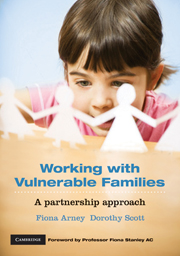Book contents
- Frontmatter
- Foreword
- Contents
- List of figures, tables and boxes
- Contributors
- Acknowledgements
- Introduction
- Chapter 1 Think child, think family, think community
- Chapter 2 Family strengths: an international perspective
- Chapter 3 Harnessing ‘resilience’ when working with children and families
- Chapter 4 Working within and between organisations
- Chapter 5 Family-centred practice in early childhood settings
- Chapter 6 Sustained nurse home visiting with families of Aboriginal children
- Chapter 7 Including fathers in work with vulnerable families
- Chapter 8 Parenting in a new culture: working with refugee families
- Chapter 9 Responding to parents with complex needs who are involved with statutory child protection services
- Chapter 10 Engaging family members in decision making in child welfare contexts
- Chapter 11 Supporting parents whose children are in out-of-home care
- Chapter 12 Using evidence-informed practice to support vulnerable families
- Chapter 13 Spreading promising ideas and innovations in child and family services
- Index
Chapter 11 - Supporting parents whose children are in out-of-home care
- Frontmatter
- Foreword
- Contents
- List of figures, tables and boxes
- Contributors
- Acknowledgements
- Introduction
- Chapter 1 Think child, think family, think community
- Chapter 2 Family strengths: an international perspective
- Chapter 3 Harnessing ‘resilience’ when working with children and families
- Chapter 4 Working within and between organisations
- Chapter 5 Family-centred practice in early childhood settings
- Chapter 6 Sustained nurse home visiting with families of Aboriginal children
- Chapter 7 Including fathers in work with vulnerable families
- Chapter 8 Parenting in a new culture: working with refugee families
- Chapter 9 Responding to parents with complex needs who are involved with statutory child protection services
- Chapter 10 Engaging family members in decision making in child welfare contexts
- Chapter 11 Supporting parents whose children are in out-of-home care
- Chapter 12 Using evidence-informed practice to support vulnerable families
- Chapter 13 Spreading promising ideas and innovations in child and family services
- Index
Summary
Learning goals
This chapter will enable you to:
Understand the role of out-of-home care in keeping children safe from harm
Identify the advantages and disadvantages of maintaining contact between natural parents and their children in out-of-home care
Develop awareness of the experiences of parents whose children have been placed in out-of-home care
Recognise the potential of child welfare practitioners to engage parents involved with the child protection system in ways that will enhance their ability to interact with their children in out-of-home care
Identify the characteristics of parenting programs that promote engagement of parents whose children are in out-of-home care.
Introduction
The last decade has witnessed a doubling in the rates of children living in out-of-home care in Australia from approximately 3.1 per thousand children (14,470 children) to 6.2 per thousand children (31,166 children) on 30 June 2008 (Australian Institute of Health and Welfare, 2009). Similar increases in the rates of children taken into care are also evident in other developed countries like England, the Republic of Ireland and the US (Department for Education and Skills, 2006; Health Social Services and Public Safety, 2006).
Disturbingly, the growing number of children requiring out-of-home care, the need to secure permanent placements for many of these children thereby reducing the capacity of existing carers to take on new children entering the system, and a reduction in the number of people willing to become foster parents has meant that only children with the most serious needs are placed in care (Bromfield et al., 2007).
- Type
- Chapter
- Information
- Working with Vulnerable FamiliesA Partnership Approach, pp. 227 - 246Publisher: Cambridge University PressPrint publication year: 2010



